The instructions are not easily digestible.
The Marshall Acton II is what audiophiles looking into assistant speakers want, nay, need. This product is everything that Marshall loudspeakers are except, this time, you also have the Amazon Alexa module, playing music and controlling smart devices hands-free.
Amazon Alexa
Stereo
One 30-watt Class D amplifier for the woofer
Two 15-watt Class D amplifiers for the tweeters
Wi-Fi, Bluetooth 5.0, 3.5-mm AUX-in port
Adjustable bass and treble control, Multi-host functionality, Marshall Bluetooth app compatible
Mains
1 year limited
The Bose Music app offers multiple shortcuts on the front "page". Using these shortcuts, you can access different podcasts, streams, feeds, radio stations, etc. Even at high volumes, this speaker keeps the output primarily distortion-free.
The programmable buttons are vague and have a response delay.
The Bose HS300 boasts an excellent sound signature, filling sizable rooms with bass-strong audio with its 360-degree output. The mic is responsive, so the device will usually recognize most commands on the first try. The controls are intuitive and easily accessible.
Amazon Alexa, Google Assistant
Mono
2 watts
Wi-Fi, Bluetooth
Apple AirPlay 2, Bose Music app compatible
Mains
2 years limited
The device is not easy to set up.
The Amazon Echo comes at the most reasonable price (less than $100) yet manages to provide pretty brilliant sound, high privacy protection levels, and convenient controls. You can choose between Bluetooth and AUX interfaces when pairing the speaker with the music source.
Amazon Alexa
Mono
15 watts
Wi-Fi, Bluetooth, 3.5-mm AUX-in port
Compatible with smart home devices, Multiple layers of privacy protection
Mains
1 year limited
The battery will usually last around 15 hours, playing music and following commands. The NFC module will provide quick and seamless pairing with NFC-enabled gadgets. The housing is protected against splashes and will usually survive temporary submersion.
The model doesn't have a Wi-Fi module.
The Cleer Stage 1 will prove equally useful indoors and outdoors. With its passive radiators, two 48-mm neodymium drivers, and digital amp, the device minimizes distortion even at high volume settings, churning out deep, spacious sound, with respectable consistency and sweet intonation.
Amazon Alexa
Stereo
10 watts
Bluetooth 4.2, NFC, 3.5-mm AUX-in, Micro USB charging port
Shockproof, IPX7 water-resistant, Cleer Connect app compatible
Rechargeable battery (up to 15 hours of playback time)
1 year
The 36-watt speaker can fill most rooms. The Blast and Megablast apps will let you enable/disable the Alexa module, customize the speaker's EQ settings, make sure the battery's recharged, and more. The massive volume controls will let you adjust the volume even while wearing mittens.
The battery life is lower than advertised.
The Ultimate Ears Blast is a blast to use. With its practically indestructible construction, this device can go anywhere without having you all worried about breaking your favorite portable speaker. When at home though, its Alexa module will not fail to control every nearby smart device.
Amazon Alexa
Stereo
36 watts
Wi-Fi, Bluetooth, Micro USB charging port
IP67 water-resistant, Dust- and shock-resistant, Hang loop, Blast & Megablast app compatible
Rechargeable battery (up to 12 hours of playback time)
2 years limited
This site is a free online resource that strives to offer helpful content and comparison features to its visitors. Please be advised that the operator of this site accepts advertising compensation from certain companies that appear on the site, and such compensation impacts the location and order in which the companies (and/or their products) are presented, and in some cases may also impact the scoring that is assigned to them. The scoring that appears on this site is determined by the site operator in its sole discretion, and should NOT be relied upon for accuracy purposes. In fact, Company/product listings on this page DO NOT imply endorsement by the site operator. Except as expressly set forth in our Terms of Use, all representations and warranties regarding the information presented on this page are disclaimed. The information which appears on this site is subject to change at any time. More info
Marshall Acton II Voice
The Cool Kid
The Marshall Acton II is that cool kid that hangs more with loudspeakers than with smart speakers. The reason probably has to do with the fact that this is as much the former as it is the latter, especially considering the company behind it. Still, this device has not just the brawn but also the brain to match the smart crowd and even outclass that crowd at times.
Now, before that, this unit might be commanding a small footprint, but its output is large. Between the two 15-watt Class D amps behind the tweeters and one 30-watt Class D amp powering the sub, this device produces punchy, mighty audio, keeping the sound balanced yet detailed.
Atop the unit, easily accessible, you will find volume, bass, and treble dials. Using these dials, you can fine-tune and customize the sound, matching different needs and preferences. Setting these analog controls aside though, the product also lets you use the Marshall Voice app, with its easily digestible UI, straightforward controls, accessible tools, and intuitive resources.
Not unlike most smart speakers, the Acton II comes fitted with Bluetooth and Wi-Fi modules. Even more than that though, the device offers multi-host access, so you can connect and switch between two Bluetooth devices, all while having the unit connected to the Wi-Fi network. Invite friends and take turns playing what you want, all without sharing not one device but this speaker.
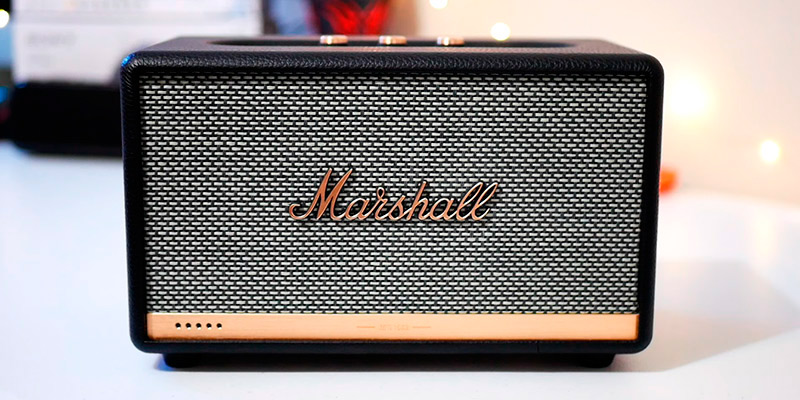
Claiming its Rightful Place
This is Marshall we're talking about, the odd man out where the assistant speakers' crowd is concerned, except, as we have established above, this one is not moving out. Still, with its iconic Marshall design, the unit is separated from its contemporaries, delivering the hard-hitting sound that's synonymous with the company but also sporting the signature retro look that so many have tried and failed to replicate.
Removing everything that the Marshall brand entails from the equation, this product lands among smart speakers owing to the integrated Alexa module. As always, using this module, you'll be able to control all smart devices at home and let Alexa do the heavy lifting on the road, playing and controlling music hands-free.
The instructions are not easily digestible, something that people have been complaining about before (with different Marshall products). But, even considering this little mishap, the Marshall Acton II easily claims its rightful place among the best assistant speakers for audiophiles.
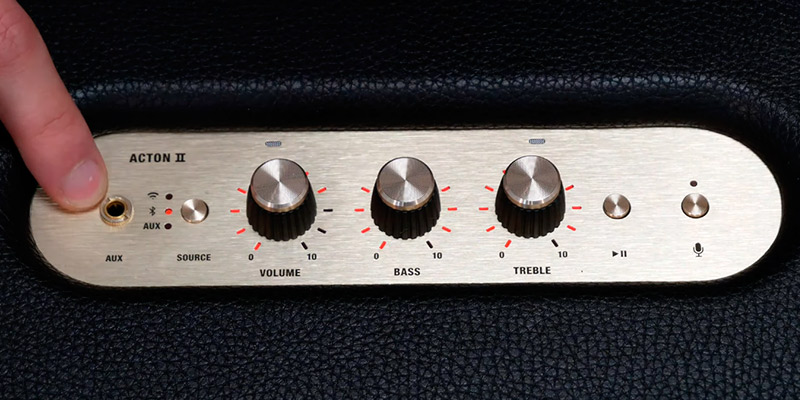
Additional Info
| Last updated price | $240.14 |
| Stock | In stock |
| ASIN | B07J4HY7GS |
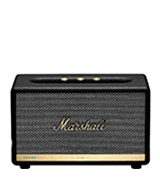
Bose HS300
Playing Music and Following Commands
The Bose HS300 plays music and follows commands with matching efficiency. At first glance, this futuristic-looking device does not necessarily appear like something that will let you enjoy awesome-sounding music yet this is precisely what this device is offering. With its 360-degree setup, the speaker produces room-rocking bass, but we are not quite going there yet.
No, first come the looks. Stretching 6.3 x 5.6 x 4.0 inches (HWD) and measuring 2.1 pounds weight-wise, this compact device can easily make a portable claim, except that it comes without an internal battery, meaning that the device remains portable as long as it is moving towards a location with an AC socket.
On the front, the speaker introduces a thin little LED strip, displaying its status. Above that, the device hosts touch-sensitive controls, including volume, play, pause, the usual suspects.
Apart from the usual suspects, flanking these buttons are the Action button, summoning the voice assistant (the product works with both Amazon Alexa and Google Assistant), the mic/mute button, the AUX button that lets you switch to the wired, 3.5-mm input, and the Bluetooth button, controlling the BT module. With the last one, you can switch to Bluetooth streaming.
Wrapping the lineup are the 6 numbered preset buttons that you can assign to respond to different radio feeds from the Bose Music app. Opening the app, you're greeted by multiple shortcuts leading you to various feeds, podcasts, radio streams, Internet radio stations, and more.
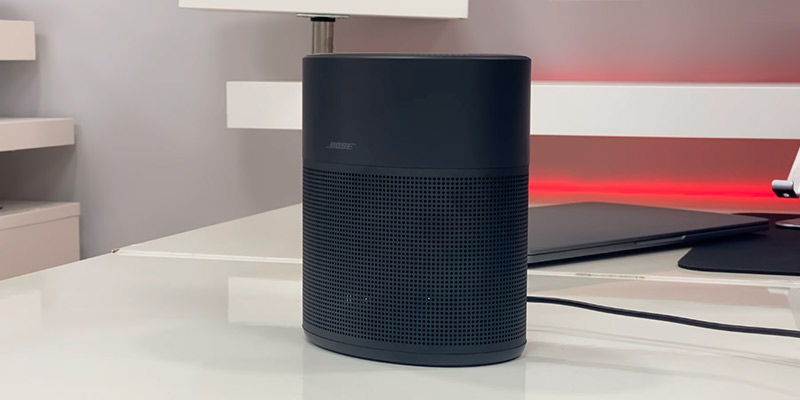
Google Assistant Compatible
Performance-wise (talking about playback), this device uses a mono speaker with a down-firing driver dispersing the audio through a reflector. According to the folk at Bose, this product's DSP (digital signal processing) unit utilizes proprietary logic, making sure that hard-panned left and right data is not disappearing from the mix. Despite the room-rocking bass remark that we have made earlier, tracks with considerable sub-bass content will have some small-time distortion at top volumes, subtle but noticeable. Nevertheless, the DSP unit will make sure the bass is not distorting, even when the volume has been dialed to the max. Depth-wise, the unit does not disappoint too, even though occasional rattle and vibrations will prove unavoidable.
All things considered, the Bose HS300 has an awesome overall sound signature, making the drums sound full and round, the bass deep and intense, and the highs practically distortion-free. Its mic is also quite good at recognizing voice commands.
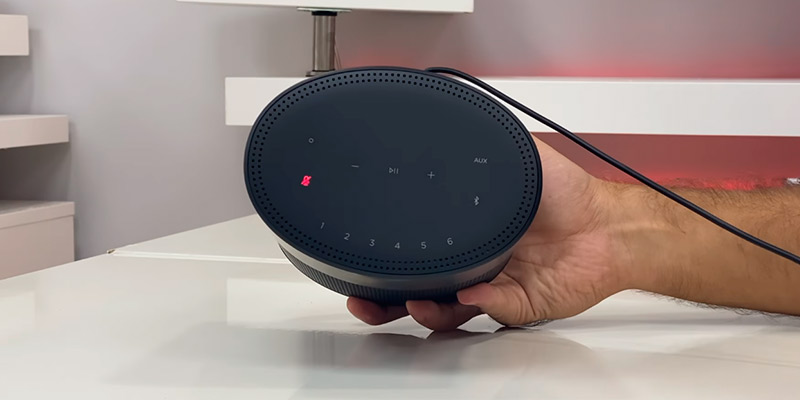
Additional Info
| Last updated price | $0.00 |
| Stock | May be out of stock |
| ASIN | B07Q337VV3 |
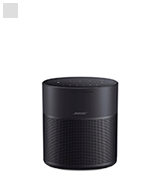
Amazon Echo (3rd generation)
Stable, Full, Resonance-Rich Sound
The 3rd generation Amazon Echo basically mirrors Echo Plus except that the ZigBee hub has been removed and the device has been made more affordable. Nevertheless, despite the affordable price, this speaker offers respectable sound. In fact, the model's acoustically identical to its more expensive relative, packing the same 3-inch sub, 0.8-inch tweeter, all without forgetting the Dolby Audio unit.
Considering its size, the unit can produce considerable bass, not quite shaking the walls, no, but the unit might rattle loose objects sitting on the same table. Most bass-heavy tracks will sound deep and thumpy, even though not quite reaching into sub frequencies. The drums might start flirting with distortion when the volume is cranked all the way up but, generally speaking, the sound will remain stable and full.
From the balance angle, the device does a laudable job separating lows from mids and highs. The acoustic plucks will usually sound resonance-rich, with some strong high-frequency string texture, while the bass will be coming at you punchy and forceful.
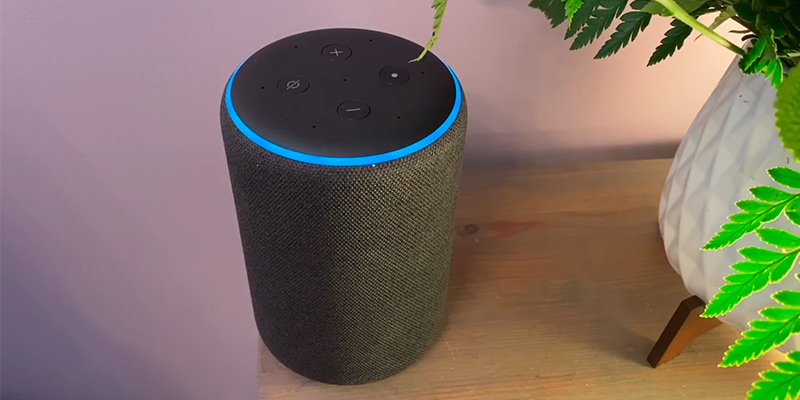
Multiple Privacy Protection Layers
In the appearance department, the 3rd generation Amazon Eco has not received noteworthy changes. Measuring 5.8 x 3.9 inches, the cylinder preserves the line's almost iconic look. On the top panel, you're offered the usual 4 buttons, including mic mute, Alexa, and volume controls. The translucent light ring surrounding them will be glowing blue when the device's listening and talking, orange when you're playing with its settings, and red when the mic is muted.
Because this is Amazon Echo and not some third-party product with an embedded Alexa module, there's not much that the unit cannot do with compatible smart devices, including countless smart locks, thermostats, outlets, lights, most home automation solutions. You can even establish complex routines, with one voice command controlling multiple devices.
Alexa's syntax and language requirements remain awkward and stiff at times compared to its more laid-back Google Assistant contemporary. But, after receiving some flak years ago, Alexa security protocols have remained excellent, with multiple privacy protection layers and the glowing light telling you when the mic is listening and when it's not.
Bottom line, the Amazon Echo is an awesome alternative to Echo Plus, reducing the price and removing unnecessary bells and whistles yet keeping the solid sound.
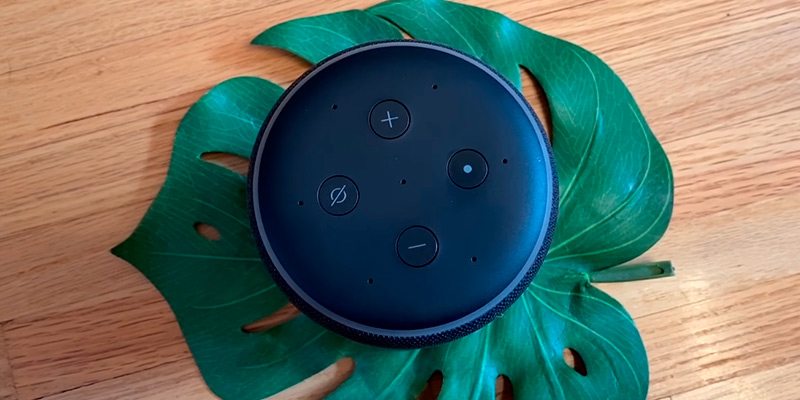
| Last updated price | $0.00 |
| Stock | May be out of stock |
| ASIN | B07NFTVP7P |
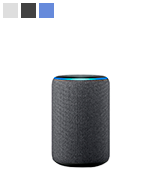
Cleer STAGE1
Portable Speaker with an Alexa Module
The Cleer Stage 1 has as much in common with most Bluetooth speakers as with assistant/home speakers. Basically, what we have here is not that different from those wireless JBL speakers that all the kids are using these days, except that the device has also been fitted with an Amazon Alexa module. Owing to this module, the model's able to identify and execute voice commands, so you can issue anything that average Alexa-enabled assistant speakers can recognize, controlling smart devices, playing music, reading news, and more.
Now, considering that Bluetooth speakers usually cost as much (and even more) than this device without integrated voice control modules, the product has its flaws, nothing can be done about that. First, even though the unit comes adopting stereo speakers, the output maxes out at 10 watts, meaning that, despite opposing claims, this device will not be filling sizable rooms, not really. Second, unlike most smart speakers, this one has not been equipped with WiFi.
The good news is that the WiFi module has been replaced with an NFC module, enabling pairing this unit with smartphones and most gadgets supporting the NFC tech without even establishing a Bluetooth connection first.

Steer Cleer
As you can imagine, the device can be used outdoors. In fact, it is encouraged. With its shockproof housing, the unit can survive considerable drops without damaging the circuitry. Next, its IPX7 construction makes the speaker waterproof, so while we do not recommend full-blown submersion, the device should be able to leave through them without facing noticeable consequences.
Notwithstanding the 10-watt output, this little guy produces solid sound, with its digital amp, passive radiators, and two 48-mm neodymium drivers making sure that the tracks are coming out crisp, punchy, and distortion-free.
Most wireless speakers usually last around 10 hours. This one's different. You would not expect that considering the model's compact footprint but the integrated battery can play music for ~15 hours straight, which is not the smallest feat, not one bit, especially considering that the device takes the same ~2-2.5 hours to recharge that most Bluetooth speakers require.
Long story short, while not without its flaws, the Cleer Stage 1 is an impressive product, even without mentioning the company's proprietary app that streamlines interactions between you and the device with its easy-to-navigate interface.
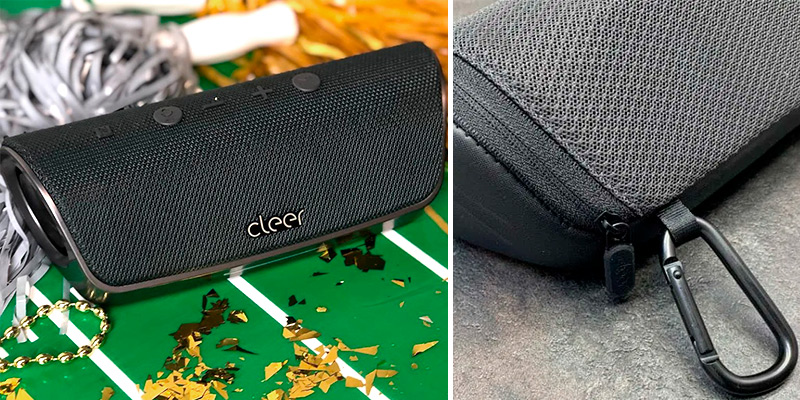
Additional Info
| Last updated price | $99.99 |
| Stock | In stock |
| ASIN | B07L6RZVXR |
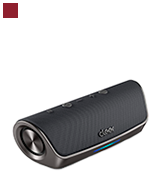
Ultimate Ears (984-001203)
Have a Blast Outside
Ultimate Ears is not the biggest name in the business but, with products like Blast, we can see that changing anytime soon. As far as we can tell, this device is consistent across the board, touting great sound, intuitive controls, even its build is nothing to scoff at. With the housing earning the IP67 rating, the unit is protected against submersion and sealed against dust. What's more, the rugged body will usually survive drops from 5-10 feet without displaying any damage signs. Setting construction aside, the device also comes equipped with a hanging loop, enabling comfortable hands-free carrying.
Considering that the device comes equipped with a rechargeable battery, you'll probably at least entertain the carrying part, bringing this speaker with you to the beach, picnics at the park, different social gatherings, etc. The battery will usually give you around 12 hours before dying out, which is not bad, not at all since even more expensive models can seldom guarantee more than 10. Plus, the same battery will usually go from 0 to 100% in ~2 hours, so keeping the speaker recharged will be pretty easy. Sure, sometimes, the battery will not provide these 12 hours, but this is always the case with wireless speakers, at least to some extent.

36-Watt Output
Aside from the Amazon Alexa module that lends the device the same functionality that all speakers with Alexa modules can boast, what separates this product from the crowd is its excellent sound output. First things first, the device pushes out 36 watts, huge numbers by wireless speakers' standards. With this output, the speaker easily fills most rooms with spacious, 360-degree music. Meanwhile, its advanced sound processing engine makes sure the output remains accurate.
Despite striving towards accuracy, the device does not sacrifice the punch, so, without artificially juicing the bass, this unit brings deep and rich bass texture, keeping the impact high and the extension consistent. Using its massive stereo speakers, this unit rolls off the highs, ensuring that the music does not sound harsh.
Design-wise, this product is a little different, not really offering a large number of controls besides the huge plus and minus signs on the front serving as volume control buttons. Instead, you'll be using either Blast or Megablast app, enabling and disabling Alexa, customizing EQ settings, checking the battery status, and more.
To sum up, the Ultimate Ears Blast comes from humble beginnings but, despite these beginnings, the product can compete with the industry mastodons.

Additional Info
| Last updated price | $0.00 |
| Stock | May be out of stock |
| ASIN | B07DGXDT3V |
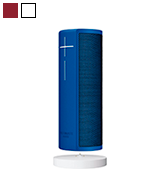
What Are Assistant Speakers?
Life can be a little hard nowadays. So much to do, so much to see (no, we're not quoting Smash Mouth, you are). So, what's wrong with taking the backstreets (alright, you got us)? The last thing you want to do when you get home is managing different devices, tweaking the settings, fiddling with various controls, etc.
Instead, assistant speakers let you come home, get on the couch, say: "Alexa/Google Assistant, adjust the thermostat 3 degrees, play my Spotify playlist, and lock the doors". Equipped with virtual assistant modules, these speakers can do much more than that, provided you have compatible smart solutions at home. But they're also speakers, meaning that they can play music. They're usually pretty good at that, even though you would expect otherwise.
Some models are even portable, so you can have them controlling smart devices at home and blasting music at the beach, not unlike Bluetooth speakers. The difference here is that, in addition to manual controls on the body and app settings, these models can recognize and execute voice commands, enabling hands-free interactions. Most people have privacy concerns but you can always turn off the microphone, so these speakers are not as invasive as people think.
What Features to Compare
Voice Assistant Module
Assistant speakers get the "assistant" part from the virtual assistant module, usually Amazon Alexa, sometimes Google Assistant (we're not discussing those fringe AIs that nobody uses here). These modules have their strengths and weaknesses. Generally speaking, Google Assistant's syntax and language requirement sound less forced, stiff, and awkward than Amazon Alexa's. At the same time, Alexa is compatible with more home automation solutions than Google Assistant, so most people will usually benefit more from the Amazon tech.
Sound
Assistant speakers are still speakers, meaning that the product's sound still largely determines its worth. First, you have monophonic and stereophonic speakers (more known as mono and stereo), the difference between which is something that most people probably already understand without us. Then, you have the output.
Normally, these speakers are ranging anywhere between 2 and 40+ watts but these numbers can be deceiving. On paper, more always means better but, in reality, different devices are not always as good (or bad) at utilizing that output, so you can have speakers not going above 10 watts yet sounding louder, clearer, and overall more impressive than models with an output above 30.
Of course, that's because audio is more complicated than that and, aside from speakers and the output, there are multiple elements contributing to the speaker's sound, including the driver(s), subwoofer(s), tweeter(s), sound processing engine, and more. The more expensive models will even let you adjust the bass output, treble, you name the setting. There are also details like the radiators determining how much noise and distortion will be present in the music coming from these speakers.
Interfaces
Most smart speakers come equipped with Wi-Fi and Bluetooth modules, with the first connecting them to the network and controlling smart devices at home and the second enabling pairing the speakers with smartphones so that you can blast music. Besides these two, at times, these speakers will include an AUX port, offering a wired connection between the device and different electroacoustic transducers.
Power Source, Compatibility, and More
There are wired and wireless assistant speakers, so you'll be choosing between models that come adopting an integrated rechargeable battery and those that connect to the mains. They're all compatible with some app, usually a proprietary one from the same company. There are many little details that separate different models, from controls to construction.
Smart Speakers Pros and Cons
Pros:
1. Keeping the home safe. Assistant speakers can be connected to smart home security devices, so you can keep the premises safe without adding extra security solutions. Connecting, say, security cameras with virtual assistants, you can use voice commands and tell the assistant to arm the home security system, even when you're not there.
2. Reducing energy bills. Smart speakers are able to manage and manipulate various smart home devices, not excluding the next-gen lighting solutions. Hooking up the smart thermostat to the virtual assistant and telling the assistant to turn off heating when you leave the house should reduce energy bills by ~16%.
3. Saving money on flights. Monitoring different deals and sales across countless platforms takes time and effort. Asking the assistant how much the flight to an X airport/city costs right now takes no time and no effort. Using search engines (not like SkyScanner), these devices can easily find bargain tickets without you spending hours looking for these tickets manually.
4. Paying Uber less. When you set up a default pick-up location, smart speakers let you hail a cab from home. When you ask the device to do that, they will usually tell you how close the closest available vehicle is, letting you change the pick-up location when necessary. Also, before you book the ride, the assistant will tell about surge pricing, so you can choose the best possible price.
Cons:
1. The savings do not come from the get-go. Even though these devices always provide time and cash savings down the road, the initial cost will be outweighing these savings at least the first few months, maybe even years. That being said, with virtual assistants becoming less and less expensive nowadays, this issue is becoming almost nonexistent.
2. Security can be an issue. Sure, the companies behind these assistants are swearing that they don't do anything questionable with your data, like selling it to advertisers. Nevertheless, they do store your personal data in the cloud, which can make the information vulnerable to hacks. Besides that, make sure that the Wi-Fi network at home is secure, keeping the password strong and the updates frequently installed.
3. Voice recognition is still iffy at times. Again, the tech has seen tremendous improvements and what was a questionable gimmick only ~10 years ago is now a reliable method of issuing commands. Having said that, even the more expensive smart speakers from brands lIke Amazon, Google, and Samsung will not process commands at times, so you will have to repeat them 'till the device recognizes the command. Do not fret though since AI-based assistants are learning and adapting to your voice as you go along, so this issue will become less frequent with time.
4. An always working microphone. Assistant speakers do not start recording and sending the voice command to the system 'till you say the Wake word, but a microphone listening to you the entire time is not something that excites most people anyway. This is not an issue though because you can always turn the mic off and can review and delete each and every voice command you have issued beforehand.


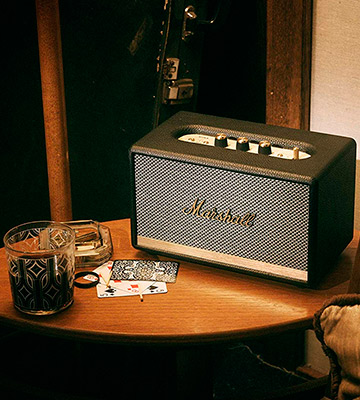
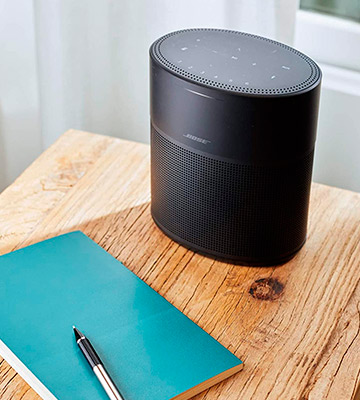
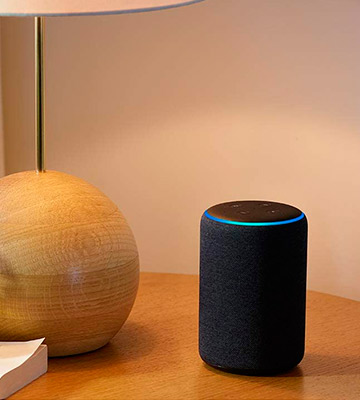
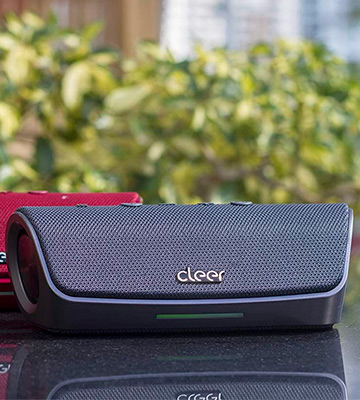


Your comment was successfully sent
Error! Please try again later